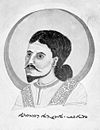Related Research Articles
Geometric Shapes is a Unicode block of 96 symbols at code point range U+25A0–25FF.
Supplemental Arrows-B is a Unicode block containing miscellaneous arrows, arrow tails, crossing arrows used in knot descriptions, curved arrows, and harpoons.
Supplemental Mathematical Operators is a Unicode block containing various mathematical symbols, including N-ary operators, summations and integrals, intersections and unions, logical and relational operators, and subset/superset relations.
Miscellaneous Symbols and Arrows is a Unicode block containing arrows and geometric shapes with various fills.
Mathematical Operators is a Unicode block containing characters for mathematical, logical, and set notation.
The Basic Latin or C0 Controls and Basic Latin Unicode block is the first block of the Unicode standard, and the only block which is encoded in one byte in UTF-8. The block contains all the letters and control codes of the ASCII encoding. It ranges from U+0000 to U+007F, contains 128 characters and includes the C0 controls, ASCII punctuation and symbols, ASCII digits, both the uppercase and lowercase of the English alphabet and a control character.
Enclosed Alphanumerics is a Unicode block of typographical symbols of an alphanumeric within a circle, a bracket or other not-closed enclosure, or ending in a full stop.
CJK Unified Ideographs Extension-A is a Unicode block containing rare Han ideographs.
CJK Symbols and Punctuation is a Unicode block containing symbols and punctuation used for writing the Chinese, Japanese and Korean languages.
Enclosed Alphanumeric Supplement is a Unicode block consisting of Latin alphabet characters and Arabic numerals enclosed in circles, ovals or boxes, used for a variety of purposes. It is encoded in the range U+1F100–U+1F1FF in the Supplementary Multilingual Plane.
Myanmar is a Unicode block containing characters for the Burmese, Mon, Shan, Palaung, and the Karen languages of Myanmar, as well as the Aiton and Phake languages of Northeast India. It is also used to write Pali and Sanskrit in Myanmar.
Mongolian is a Unicode block containing characters for dialects of Mongolian, Manchu, and Sibe languages. It is traditionally written in vertical lines Top-Down, right across the page, although the Unicode code charts cite the characters rotated to horizontal orientation as this is the orientation of glyphs in a font that supports layout in vertical orientation.
Myanmar Extended-A is a Unicode block containing Myanmar characters for writing the Khamti Shan and Aiton languages.
Variation Selectors Supplement is a Unicode block containing additional Variation Selectors beyond those found in the Variation Selectors block.
CJK Unified Ideographs is a Unicode block containing the most common CJK ideographs used in modern Chinese, Japanese, Korean and Vietnamese characters. When compared with other blocks containing CJK Unified Ideographs, it is also referred to as the Unified Repertoire and Ordering (URO).
Phags-pa is a Unicode block containing characters from the 'Phags-pa script promulgated as a national script by Kublai Khan. It was used primarily in writing Mongolian and Chinese, although it was intended for the use of all languages of the Mongol Empire.
Mahjong Tiles is a Unicode block containing characters depicting the standard set of tiles used in the game of Mahjong.
Enclosed Ideographic Supplement is a Unicode block containing forms of characters and words from Chinese, Japanese and Korean enclosed within or stylised as squares, brackets, or circles. It contains three such characters containing one or more kana, and many containing CJK ideographs. Many of its characters were added for compatibility with the Japanese ARIB STD-B24 standard. Six symbols from Chinese folk religion were added in Unicode version 10.
Halfwidth and Fullwidth Forms is the name of a Unicode block U+FF00–FFEF, provided so that older encodings containing both halfwidth and fullwidth characters can have lossless translation to/from Unicode. It is the last of the Basic Multilingual Plane excepting the short Specials block at U+FFF0–FFFF. Its block name in Unicode 1.0 was Halfwidth and Fullwidth Variants.
Variation Selectors is the block name of a Unicode code point block containing 16 variation selectors. Each variation selector is used to specify a specific glyph variant for a preceding character. They are currently used to specify standardized variation sequences for mathematical symbols, emoji symbols, 'Phags-pa letters, and CJK unified ideographs corresponding to CJK compatibility ideographs. At present only standardized variation sequences with VS1, VS2, VS3, VS15 and VS16 have been defined; VS15 and VS16 are reserved to request that a character should be displayed as text or as an emoji respectively.
References
- ↑ "Unicode character database". The Unicode Standard. Retrieved 2016-07-09.
- ↑ "Enumerated Versions of The Unicode Standard". The Unicode Standard. Retrieved 2016-07-09.
- 1 2 Everson, Michael; Durkin-Meisterernst, Desmond; Pournader, Roozbeh; Afshar, Shervin (2011-05-10). "N4029R: Second revised proposal for encoding the Manichaean script in the SMP of the UCS" (PDF). Working Group Document, ISO/IEC JTC1/SC2/WG2.
- ↑ "Unicode Character Database: Standardized Variation Sequences". The Unicode Consortium.
